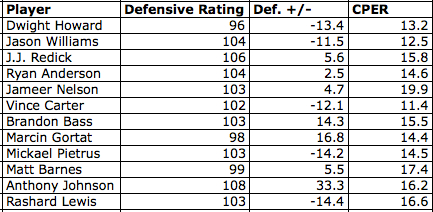The following is part of a weekly series at the Orlando Magic blog, Third Quarter Collapse.
(Note: These stats are updated through November 27. Games from this past weekend aren’t included. )
For those who are unaware, every year I calculate a statistic called Composite Score (numbers are here and here) for each player. Composite Score is a rating system that combines six different advanced statistics, with three measuring offense and three measuring defense. The offensive statistics are Offensive Rating, Offensive Plus-Minus, and PER. The defensive statistics are Defensive Rating, Defensive Plus-Minus, and Counterpart PER (the estimated PER allowed on defense by a player). These numbers can be obtained from Basketball-Reference.com and 82games.com.
Although I can’t compute Composite Score for Magic players just yet (because of the way its calculated, I need the stats for every player in the league before I can calculate Composite Score), I can still present how every Magic player has fared in the individual components. I will break things down into offense and defense. Below is a table presenting every Magic player’s offensive performance so far, as measured by the three offensive statistics I mentioned earlier:

Dwight Howard has been excellent as usual. Jason Williams has been a pleasant surprise and has been particularly efficient, posting an Offensive Rating of 123. His Offensive Rating is second on the team to J.J. Redick. Believe it or not, the best newcomer offensively this year for the Magic has been Ryan Anderson. Of course, don’t go crazy about his offensive plus-minus just yet. That number can be flammable, and it is particularly unreliable this early in the year. I included it for the sake of completeness, but I rarely use it for reference this early in the season.
By his standards, Vince Carter has struggled offensively. His PER is still relatively good, but his Offensive Rating is below the league average. Before his injury, Jameer Nelson was also failing to meet expectations, but again, he wasn’t bad either. With the exception of Brandon Bass, many of the reserves have struggled somewhat on the offensive end, posting PER’s and Offensive Ratings below league average. Following his return from suspension, Rashard Lewis has struggled perhaps as much as anyone else on the team. His efficiency has been well below his usual rates.
Next, let’s take a look at defense:

Again, I wouldn’t draw too many conclusions from the plus-minus numbers. As you can see from the table, if we were to take them at full value, we’d think the Magic is a team that is half defensive superstars and half defensive liabilities.
To start, Dwight Howard has been just as good on the defensive end as he’s been offensively. A Counterpart PER of 13.2 for a center is particularly impressive. Perhaps riding the coattails of players like Howard, Williams has posted good defensive numbers as well. He’s never had the reputation of being a lockdown defender, but his effort has been solid.
Looking down the list of defensive stats, we see nothing out of the ordinary except for a few things. Nelson’s CPER is very high, especially for a point guard. Carter’s, on the other hand, is very low (more on this later). Anthony Johnson’s plus-minus is comically bad, although that’s almost certainly the result of a small sample size. Finally, Matt Barnes looks great defensively according to Defensive Rating, but below average according to CPER. We’ll see how those numbers progress as the season goes on.
Back to Vince Carter’s defense. A couple of weeks ago, I wrote an article comparing his defense to Hedo Turkoglu’s. In the article, I said:
Here, Turkoglu strikes back. Carter looks below average in just about every category, and this supports his reputation. Turk, on the other hand, recorded numbers well above average in every category. The trickiest part about these comparisons is team context. It is something I’ve mentioned constantly when talking about my Composite Score numbers. Because of the way stats are tracked (at least publicly), it’s very difficult to separate a player’s individual contribution to his defense. How much of this is Hedo’s own doing, and how much of it is due to the fact that Orlando featured a very strong all-around defense? It’s hard to say, but I do think Turkoglu was probably a better defender than Carter.
Looking at Carter’s numbers in the early going, we can see that the team you’re on sure has a huge impact on your defensive numbers. He is better in every defensive category. How does he compare to Turkoglu now?

Turkoglu’s Defensive Rating has skyrocketed to 116, but his other defensive stats are still very impressive. This year, it’s hard to tell which player is better on defense. Carter has a low Defensive Rating and his plus-minus is very, very negative, but we don’t know how much that means yet. I think the lesson to take from this is that defensive statistics are pretty unreliable, especially this early in the season.
We’ll have to return to these numbers in about a month or so. The longer we wait, the clearer the picture becomes.